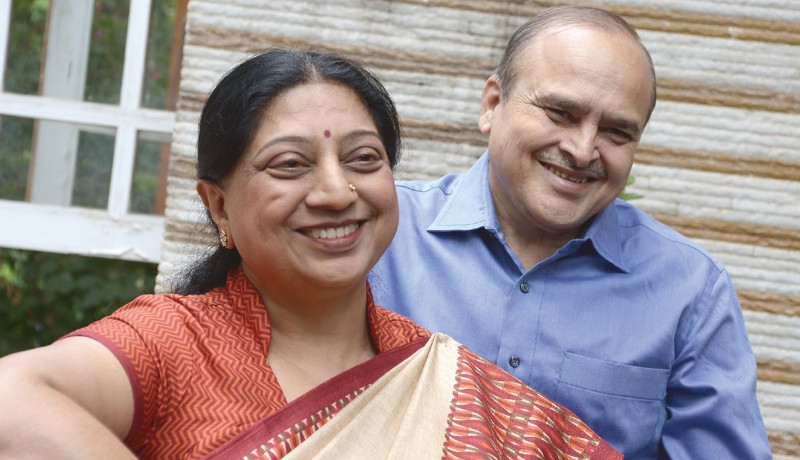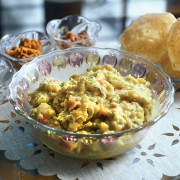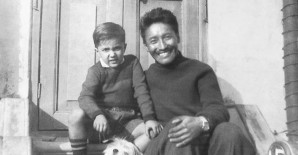
Columns

A series by Pratibha Jain about silvers who believe nurturing the body and mind is the key to joy.
Featuring Chandra and Mahavir Kataria from Bengaluru
Ever since I have known them, the Kataria family has been an exemplary model of togetherness. Despite having moved into independent homes, they are still bound by a common thread of love and affection. Indeed a rarity in today’s day and age, to find a family that is woven together with a strong value system and honest bonding.
Family holidays see a bunch of family members packing in lots of fun, adventure and laughter. Meeting 57 year-old Chandraji and Mahavirji, 63, a Rajasthani couple from Bengaluru, I was deeply touched by their mutual love and respect, as well as their common approach to life. Their warmth coupled with their engaging hospitality shines right through, making people feel special and cherished.
As we chatted at their beautiful home, time stood still. It also gave me an insight into their secret mantra for happiness. The Kataria edifice is built on the foundation of strong family values, unity, love, mutual respect and conforming to change without compromising on the essence of what binds a family together.
Your family has always been known for its traditional values and lifestyle. Do you notice any changes over the years?
Mahavir: Change is gradual and yet a constant; it is bound to happen. Yes, our lifestyle has changed but at the core, our values remain the same.
Chandra: I think some change is inevitable with each generation. Today’s youngsters are more aware. When I got married, I did what I was told. It never occurred to me to do otherwise.
Paint a picture for us of what it was like back then.
She: I will give you the larger picture. I had four mothers-in-law at home: my husband’s mother, his grandmother, and two of his grandfather’s aunts. You can imagine how daunting that must have been.
Was your mother-in-law strict?
She: No, she wasn’t; but even through her silent communication, all the bahu knew exactly what was expected of them.
He: Yes that’s true. She never scolded anyone and, in fact, tended to be a little on the meek side. Yet we all understood what was expected of us.
Chandraji, was it very different from your parents’ house?
She: My family was also traditional, but I was brought up amid a lot of laad [pampering]. So after marriage it all seemed very different. We were expected to wear only ghaghra-odhani and observe a long ghunghat. We never spoke to our elders; all communication happened with ishara [sign language]. What was common between the two homes was hospitality. For Rajsthanis, manuhaar [hospitality] is an integral part of life.
He: At any given time, there would be guests at home. Hence hospitality, caring, good food and warmth were a part of our life.
I still remember the mud chulha in your kitchen. I think it continued there long after your other relatives transformed their kitchens.
She: It is still there, though barely used now. But I firmly believe that food cooked on it, especially in mud pots and brass vessels, is tastier and more aromatic than food cooked on gas and other modern-day appliances.
Mahavirji, did you join the family business?
He: Yes I did, as after school hours we used to help in the family business. My father, Fatehchandji Kataria, also had a keen interested in education. I did my schooling in
Rishi Valley and my higher studies at Central College, Bengaluru. Apart from that, being involved in the family business at a young age gave my brothers and me a better capacity to understand the business. My grandfather Hirachandji Kataria was not educated, but was fluent in six languages on account of his vast business experience.
Your have been president of the Bangalore Stock Exchange. Tell us more….
He: Yes, it was during my tenure that we undertook the computerisation of the Bangalore Stock Exchange; overnight, that changed the exchange ranking to 5th in India.
And how did the great dream of Agastya happen?
A few like-minded visionaries—the late Dr P K Iyengar (former chairman of the Atomic Energy Commission), late Dr S Balasundaram (former principal of Rishi Valley School), late Sri K V Raghavan (former chairman of Engineers India Ltd), Ramji Raghavan (then a London-based banker and consultant), industrialist Prabhakara Rao—and myself got together to create Agastya International Foundation. It is an NGO and has grown into one of the largest hands-on science education programmes for children and teachers. Today, we offer over 180 mobile science labs, night village education programmes for children and the community and run over 60 science centres. With more than 900 employees, Agastya spans 16 states reaching out to 1.5 million children every year. I have been one of the founders and have served as managing trustee of Agastya since inception.
Such commendable work! Are your family members involved?
Chandra helped us initially with hospitality, housekeeping and the kitchen. My daughter Sheetal helps with branding and design and is in charge of the art centre. I had also received a lot of encouragement from my father to devote my full energy to this endeavour. He used to keep a daily tab on the activities and programmes.
Whether it is work, society or family, one can see your keen interest and attention to detail.
He: I think I inherited this trait from my elders. My father and grandfather were active members of society and involved in social work. And more than anything, my wife makes it all possible for me, with her understanding and generosity. She makes life an easy journey.
What’s on your bucket list, Chandraji?
She: I am happy with the way things are. However I often wish I had the drive to start a beauty clinic as I am interested in grooming, skin and hair.
I am well aware that the family admires you for that. You always seem to have beauty tips to share.
She: I needed the push to do it professionally, but never had the awareness earlier.
Do you think this is one major difference between your generation and gen-next?
She: Certainly! Earlier, relationships were based on obedience and compliance. Now, relationships are based on understanding and mutual respect. Even in my relationship with my daughter-in-law Monica, I treat her as an individual in her own right. My son and she are both chartered accountants and work together. She knows what she wants to do. I appreciate that.
And where is the confluence of all these streams for your entire family?
She: At the dining table! Food has always been an important and integral part of our lives. Eating together is not just sharing and nurturing; it also plays an important role in building family bonds.
RAJASTHANI PITLA
A quick side-dish made with gram flour, this is a popular Rajasthani recipe and the ultimate comfort food. Traditionally, it was made without onions, tomatoes and garlic in Jain homes, and tasted equally delicious. Often, it would be made just as dinner was being served, and eaten hot and fresh! When kept for a few hours, it tends to thicken. In that case, simply add some hot water, mix well and cook for a few minutes before serving.
Ingredients
- Gram flour (besan): 1 cup
- Onion: 1; chopped fine
- Mustard seeds: ½ tsp
- Asafoetida powder: a pinch
- Garlic: 3 cloves; chopped fine
- Green chillies: 2; chopped fine
- Curry leaves: 10-12
- Tomato: 1; chopped fine
- Chilli powder: ½ tsp
- Turmeric powder: ¼ tsp
- Salt to taste
- Coriander leaves for garnishing
- Oil: 2 tbsp
Method
Churn the besan in 2 cups of water using a hand blender. Heat the oil in a thick-bottomed (or non-stick) pan. Add the mustard; as it starts popping, lower the flame and add the asafoetida powder. Add the chopped onions and sauté for 2-3 minutes. Add the finely chopped garlic, green chillies and curry leaves. Sauté for a minute. Add the chopped tomatoes, chilli powder, turmeric powder and salt. Cook for 2 minutes. Add the gram-flour liquid and cook for 10-15 minutes, stirring continuously so no lumps are formed. (You may need to add another half cup of water if the mixture is too thick. Its consistency should be like cake batter.) When the mixture leaves the sides of the pan, switch off the flame. Garnish with chopped coriander leaves. Serve hot with puris.
Pratibha Jain, an author and translator from Chennai, is the co-author of two award-winning books Cooking at Home with Pedatha and Sukham Ayu. Her area of specialisation is documenting Indian traditions through research, translation and writing
Photos: Srivatsa Shandilya Featured in Harmony — Celebrate Age Magazine August 2016
you may also like to read
-
Mental workout
Mukul Sharma tells you how to keep those grey cells ticking Everyone will ultimately lose his or her brain….
-
Helpline
Dr Harshbir Rana answers your queries on personal and social issues related to ageing, elder care and intergenerational relationships ….
-
Off the cuff
Raju Mukherji pays tribute to his first hero, Tenzing Norgay, an exemplary mountaineer Darjeeling, 1955. Dr ‘Pahari’ Guha Mazumdar….
-
Yoga RX
Shameem Akthar shows ways to control debilitating ankle pain through regular practice Ankle pain is so common and prevalent….








